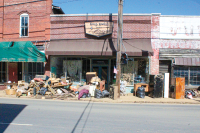Waynesville’s slow march to a better South Main
A group of vacant, ramshackle buildings at an anchor intersection on South Main Street in Waynesville has been purchased, signaling continued revitalization could be in store for the rag-tag corridor.
South Main has witnessed a slow but steady transformation over the past three years, fueled in part by national chain stores and fast-food joints piggy-backing on the arrival of Super Walmart. The recession tempered predictions that South Main would become an overnight hotbed of commercial development, but Thomas Morgan, owner of Mountain Energy and its chain of convenience stores, gas stations and fast-food enterprises in the region, purchased the corner lot of South Main and Allens Creek. The corner was comprised of four lots of varying sizes and all owned by different parties — which Morgan amassed to pull off the deal.
The sale price in total was $1.5 million for 1.3 acres, according to county property records. An empty building that once housed Carole’s Fine Foods and a vacant two-story cinderblock warehouse sit on the lot now.
The property is catty-corner to an existing Shell Station owned by Morgan. The parcels were purchased by a newly formed LLC called Mountain Star Development, for which Morgan is a key principle, according to N.C. Secretary of State filings. Morgan did not return messages seeking comment.
Rumors are flying over what might come to the intersection, and most involve a fast-food chain or two, given the size of the site.
No matter what gets built, it will be a marked aesthetic improvement, according to Fred Baker, Waynesville public works director and acting town planner. The town’s smart growth principles require new commercial development to uphold basic architectural and landscaping standards, including sidewalks and street trees.
Related Items
“It is still going to be corporate architecture,” said Baker, referencing the likelihood of fast-food joints coming to the site. “But they will be creating a public zone. You’ll have a sidewalk that didn’t exist and trees that separate the sidewalk from the street.”
The South Main of old was an amorphous sea of asphalt, with parking lots morphing into the street. As lots redevelop, the interface with the street must include defined curbs and a single parking lot entrance, limited to right turns in and out of businesses except at lights.
“We are getting some access management we didn’t get before. Things are getting better organized for the density,” Baker said.
The streetscape is improving in patchwork fashion as new businesses crop up, but over time South Main will see a unified, improved look, he said.
South Main fell into decline after the Dayco rubber plant shut down in the mid-1990s, laying off more than 1,000 workers. Mom-and-pops that once catered to Dayco’s blue-collar workforce soon began to close.
South Main devolved into an eyesore: a hodge-podge of run-down buildings, cracked parking lots over-grown with weeds and a hulking, shuttered factory deemed a Superfund site due to environmental contamination.
When Dayco was bulldozed to make way for the Super Walmart shopping complex in 2008, it was heralded as the beginning of a commercial renaissance — albeit of the fast-food and chain store variety — but revitalization stalled out of the gate.
While the recession stymied South Main from taking off, it’s seen a clear uptick in activity in the past couple of years.
• Belk department store, Michael’s craft store, Rack Room shoes and Pet Smart opened in 2012.
• Old Town Bank and a new Waynesville liquor store opened in 2013.
• A Taco Bell and Mattress Firm opened earlier this year, with the lots where they were built going for a total of $900,000.
The town commissioned a street study in 2012 to set the stage for how the corridor should be developed to make it more pedestrian-friendly and aesthetically appealing. A make-over hinges on two key ingredients: commercial development and a big-ticket street redesign by the Department of Transportation.
Until traffic congestion gets bad enough, which depends on more commercial development, DOT is unlikely to take on a total street redesign.
“I don’t think you will see much implementation of the corridor plan until you see some redevelopment,” Baker said.









